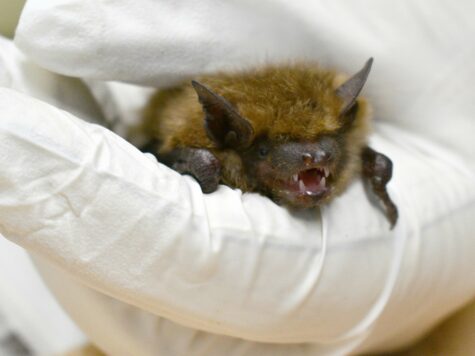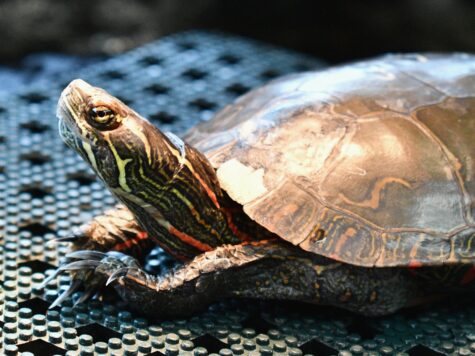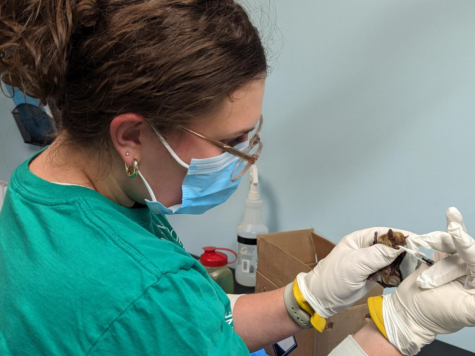Extra time with our cats often raises more questions than answers when it comes to understanding these feline friends. This makes now the perfect opportunity to dedicate time to helping you and your cat coexist comfortably in your house! DCHS Senior Animal Caretaker and cat aficionado, Mackenzie Korpela has gathered up some of the most frequently asked questions and is offering new ideas for how to improve your relationship!
To view part one of this two-part series, you should check out this list of helpful recommendations.
1) I feel like my cat is acting aggressively. How do I get them to calm down?
Before we dive into how to fix behavior, let’s make sure your cat is actually being aggressive and not just overstimulated.
- An aggressive cat is a cat displaying behavior intended to intimidate or scare another person or animal. A cat acts this way when they feel threatened and they’re trying to defend themselves. If your cat is really acting aggressively, it’s best to give them space to calm down on their own.
- An overstimulated cat displays inappropriate behavior (nipping, hissing, swatting or growling) to a particular stimulant (being carried, petting or seeing other animals). With an overstimulated cat, they could be using this naughty behavior to either tell you “I want more” or “please stop”.
When your cat next starts acting sassy, take a step back and look at the circumstances that lead to them acting wound up. Were you touching a certain part of their body? Did they see a neighbor dog outside a window? Did you try picking them up in a particular way?
Once you figure out the stimulant, it should become more predictable when your cat is going to react negatively. It will also be easier to warn other family members or guests ahead of time and make sure they avoid the trigger. You can also work to train away or improve the behavior with treats and consistency. For example, my cat, Nano, used to bite my hand when he wanted more pets. I started training him using a marker word (“nice”), shaping and positive reinforcement. Eventually, he and I got to the point where I would reward him (giving him more pets like he wants) for asking for pets by licking or tapping my hand with his paw. For more information on how to train your cat, check out this article.
Regardless of whether your cat is acting aggressive or overstimulated, they’re not doing it because they enjoy being mean to you. They’re either acting out of fear or they’ve learned some pretty bad manners as they’ve grown up.
2) How do I get my cat to use a scratch post instead of my furniture?
Most people would be surprised to learn that a lot of cats know what a scratch post is and how to use it. As soon as you bring your cat home, offer one to them!
- If they seem totally oblivious to the presence of this fancy shmancy scratch post, try using some catnip to lure them over. If it’s an incline scratcher or a floor scratcher, feel free to sprinkle some on the scratch part itself.
- Also, try different types of posts if you can. There are vertical posts (the taller the better, cats use scratch time to stretch too), wedge or incline scratchers, flat floor scratchers and different scratchers with toys attached to them.
- If your cat is using their scratcher and your furniture in addition, there are a few things you can try. Try moving a scratcher close to the piece of furniture they’re using to offer an alternative. You can also put on some double-stick tape to the spot on your furniture so that part becomes unsatisfying for your cat to touch. If they’re scratching different furniture in multiple rooms, add more scratchers throughout your house.
It’s natural for cats to scratch and stretch, you just need to find the right combination of outlets to let them do that! More information about redirecting this behavior is available here.
3) How do I trim my cat’s nails? Wouldn’t it be easier to just declaw them?
Trimming your cat’s nails can be really easy! If you live in a household with at least 2 adults, it’s easy to have one person restrain your cat in a towel wrap and/or by scruffing them (I promise, it doesn’t hurt them) with the extra skin on their neck. That way, you have one “restrainer” and one “clipper”, and you can get the job done pretty quickly.
For a single cat parent, there are some tricks you can use to ease your cat into feeling comfortable with handling their feet. First, you can do some positive association with touching/holding their feet. You can offer a treat every time and work up to holding their foot slightly longer. Start with gentle touching, then holding the foot, then gently flexing the paw pads so the nail is exposed. If your cat is very food motivated, smear some canned food on a paper plate (smearing makes it harder to eat quickly) and clip their nails while they’re distracted. The more frequently you do this and reward your cat, the easier it’ll become over time. When physically clipping the nail itself, you should be able to see where the blood pocket begins when the cat’s nail is fully flexed out. Cat nails are usually clear, so you should see a dark blob about halfway down. Try not to clip too close to that spot, it can be painful for your cat if you do!
Declawing is a surgery where the first knuckle on each paw pad is removed. It can be a painful recovery for your cat and has the potential to be painful for the rest of their life. Having nails is a natural part of a cat’s life; they use their nails to help bury their potty in the litter box. Removing those nails can make using the litter box uncomfortable and potentially painful for your cat, which can lead to litter box problems down the road. Cats also use their nails as a line of defense, both during playtime and when they feel threatened. Declawing your cat could lead to more bitey behavior due to their teeth now being their only way of defending themselves. It’s also just plain cheaper to buy a scratch post, double-stick tape, and a pair of cat nail clippers! Learn more about trimming cat claws and encouraging your cat to scratch on appropriate surfaces.
4) Do I need to bathe my cat the way I bathe my dog?
Cats are actually the complete opposite of dogs in this way! The best person to bathe your cat is your cat. Cats do a wonderful job of grooming themselves and it’s almost always enough to keep them clean. The only exception to this rule is if your cat needs to be bathed for medical reasons, or if they’ve made a mess of themselves with some canned food or with diarrhea and litter. Bigger messes are harder for a cat to groom away on their own, so they may need some help from you. Otherwise, just leave your cat to it!
If your cat has developed an odd odor that’s just driving you crazy, a good compromise might be brushing in some cat-safe no-rinse shampoo. This way, they just think they’re getting a nice brushing, and you’re helping them to smell like flowers. Brushing, in general, is always a good way to help your cat maintain its coat. It can help reduce the amount of shedding hair they’re ingesting (which means fewer hairballs), help get rid of dandruff and keep them from developing mats. Just make sure you choose the appropriate brush for what you’re trying to accomplish. For example, a Furminator is meant to get as much loose hair as possible off your cat, while a comb is more helpful in untangling mats. A bristle brush helps more with dandruff or brushing in no-rinse shampoo. Just like with nail clipping, try to make brushing as positive of an experience as possible. If you sense any hesitation in your cat, use treats or other pets to help them relax. For more information on helping your cat stay well-groomed, check out this resource from the ASPCA.
5) Should I let my cat loose outside?
It might feel normal to let your cat outside because you’ve seen feral cats or loose farm cats, but it’s safest for your cat to stay inside. It’s true, cats do enjoy the enrichment the outdoors provide: watching prey animals, different smells and exploring new places. However, the potential negative outcomes (disease, becoming wounded or killed, disappearing completely) outweigh all the fun you think your cat might have. Plus, a lot of that enrichment can be supplemented inside your house. Playing with your cat using a wand toy makes your cat feel like they’re hunting prey. A leash walk gives them the chance to get their outdoor sniffs, but eliminates the chance that they might run off. You can also build or buy cat trees, toys and shelving to help make the indoors as exciting as possible.
The City of Madison and Dane County have very specific leash laws that need to be followed by owners and their animals (more information on that here). Animals, both cats and dogs, are not allowed to run at large, which means alone and not under the control of the owner. If found and returned to the owner, you can be fined. Overall, it’s just less worry and hassle to keep your cats inside with you!
6) I’m thinking of getting another cat. Does age or sex matter when finding a new friend?
There are some criteria to think about when choosing a cat friend for your cat, but sex of the cat isn’t usually one of them. So long as both cats are spayed and neutered, there aren’t really any issues that have to do with the sex of the cats. There have been a few studies that suggest that opposite-sex pairs of cats have the best potential to get along, with male-male cat pairs coming in second, and female-female pairs coming in a very close third. Some adopters also have sex preferences based on past cat experiences, and that’s okay too. Just don’t get too hung up on the sex of your future cat; it’s not really going to be a main factor.
The important things to consider in a new cat is temperament and age. Just like with people, you want their personalities to match up so they don’t get frustrated with one another for being so different. It is also important to think about age- the older the cat, the less active they usually are. The younger the cat, the more energy and fewer manners they tend to have. Kittens may be adorable, but you don’t want to condemn your senior cat to spend their final years having their tail chewed on by a kitten. You should do your best to find a match for your cat, but be prepared for the possibility that it still might not work out. If progress becomes stalled in the introductions process and you can’t get to the point where they can happily be together alone, then it might be time to call it. It doesn’t do you or the cats any good if your home is a constant stress-zone.
DCHS offers many resources and help to make your kitty's first impressions of their new friend good ones. Check out our Cat-Cat Introduction Guide here.
I hope I've answered many of your common feline questions, and you take the extra time with your cat as an opportunity to better your lives together! Thank you!






